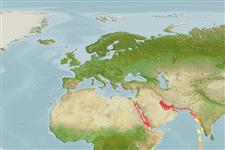Classification / Names
Nomi Comuni | Sinonimi | Catalog of Fishes(Genere, Specie) | ITIS | CoL | WoRMS | Cloffa
>
Pleuronectiformes (Flatfishes) >
Soleidae (Soles)
Etymology: Aseraggodes: Greek, aggos, -eos, -ous = vessel, uterus, carapace of a crab + Greek, aseros, -a, -on = to remove the appetite (Ref. 45335).
More on author: Chabanaud.
Environment: milieu / climate zone / depth range / distribution range
Ecologia
marino demersale; distribuzione batimetrica 35 - 68 m (Ref. 57561). Tropical
Western Indian Ocean: Red Sea.
Size / Peso / Age
Maturity: Lm ? range ? - ? cm
Max length : 7.9 cm SL maschio/sesso non determinato; (Ref. 57561)
Short description
Morfologia | Morfometria
Raggi dorsali molli (totale): 59-67; Raggi anali molli: 40 - 45; Vertebre: 35. Diagnosis: Dorsal rays 62 (59-67); anal rays 43 (40-45); dorsal and anal rays unbranched; caudal rays 18, the upper 3 and lower 2 unbranched, the remaining rays mostly double branched; pelvic rays 5, unbranched; lateral-line scales 62 (62-72), including 8 (7-10) anterior to upper end of gill opening; lateral line projecting anteriorly toward dorsal edge of upper eye; vertebrae 35 (5 specimens) to 36 (5 specimens); dorsal pterygiophores anterior to fourth neural spine 10-11 (one of nine with 10); body depth 2.3-2.7 in SL; head length (HL) 3.45-4.15 in SL. Remaining measurements just for lectotype: snout 3.05 in HL; preorbital length 3.5 in HL; eye diameter 6.95 in HL; interorbital space 16.5 in HL; tubular anterior nostril short, not reaching cutaneous anterior edge of eye when laid back; maxilla extending posterior to a vertical through middle of lower eye, the upper-jaw length 3.8 in HL; upper end of gill opening on a horizontal passing through ventral edge of lower eye; cirri on front of snout and ventral side of head slender and small; slender cirri along edge of operculum at gill opening on blind side; no cirri detected on dorsal or anal rays; no caudal peduncle depth of caudal-fin base 1.7 in HL; longest dorsal and anal rays 1.6 in HL; caudal fin short, 4.3 in SL; pelvic-fins just reaching base of second anal ray, the ocular-side pelvic fin longer; longest pelvic ray 2.7 in HL; color of ocular side of lectotype tan, the fins pale yellowish; color in formalin as reported: very pale, uniformly and densely dotted with brown, with some larger dots of the same shade of brown, especially on fins (Ref. 57561).
Life cycle and mating behavior
Maturità | Riproduzione | Deposizione | Uova | Fecundity | Larve
Goren, M. and M. Dor, 1994. An updated checklist of the fishes of the Red Sea (CLOFRES II). The Israel Academy of Sciences and Humanities, Jerusalem, Israel. 120 p. (Ref. 12541)
IUCN Red List Status (Ref. 130435)
Threat to humans
Harmless
Human uses
Informazioni ulteriori
Nomi ComuniSinonimiMetabolismoPredatoriEcotossicologiaRiproduzioneMaturitàDeposizioneSpawning aggregationFecundityUovaEgg development
Age/SizeAccrescimentoLength-weightLength-lengthLength-frequenciesMorfometriaMorfologiaLarveDinamica popolazioni larvaliReclutamentoAbbondanzaBRUVS
BibliografiaAcquacolturaProfilo di acquacolturaVarietàGeneticaElectrophoresesEreditarietàMalattieElaborazioneNutrientsMass conversion
CollaboratoriImmaginiStamps, Coins Misc.SuoniCiguateraVelocitàModalità di nuotoArea branchialeOtolithsCervelliVista
Strumenti
Special reports
Download XML
Fonti Internet
Estimates based on models
Preferred temperature (Ref.
123201): 22.3 - 28.2, mean 23.6 °C (based on 20 cells).
Phylogenetic diversity index (Ref.
82804): PD
50 = 0.5000 [Uniqueness, from 0.5 = low to 2.0 = high].
Bayesian length-weight: a=0.00977 (0.00473 - 0.02021), b=3.07 (2.90 - 3.24), in cm total length, based on LWR estimates for this (Sub)family-body shape (Ref.
93245).
Trophic level (Ref.
69278): 3.5 ±0.5 se; based on size and trophs of closest relatives
Resilienza (Ref.
120179): Alto, tempo minimo di raddoppiamento della popolazione meno di 15 mesi (Preliminary K or Fecundity.).
Fishing Vulnerability (Ref.
59153): Low vulnerability (10 of 100).
